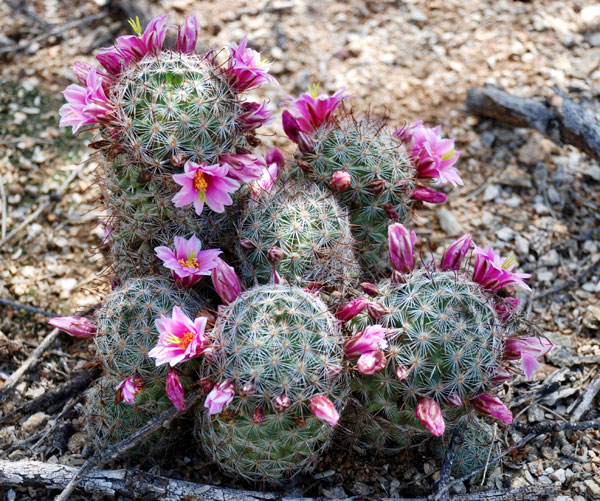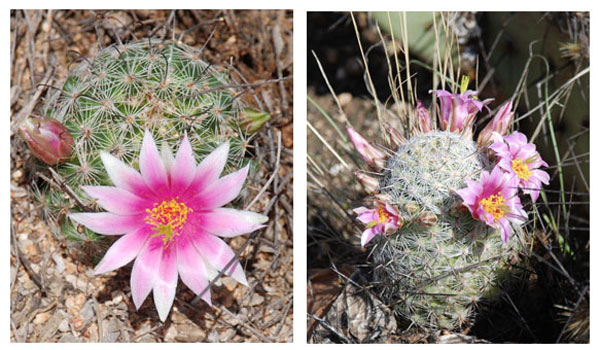Previously known as M. microcarpa, this species, in series Ancistracanthae, is abundant in habitat but is reputed to be difficult in cultivation. It was described by George Engelmann in 1856 and named after Colonel James Duncan Graham (1799-1851), a topographical engineer, and surveyor. Its habitat is widespread as it is found across the southern parts of Arizona, New Mexico and Texas in the USA and in the states of Sonora, Sinaloa and Chihuahua in Mexico.

Fig. 1 Mammillaria grahamii in habitat
These small cacti are found in desert mountains, sandy or rocky canyons, washes and plains. They also grow in sparse woodland, among desert creosote shrub or in grassland, and consequently this is a variable plant. The name M. macrocarpa was considered a separate species and referred to the larger-growing western form. Also still found on labels in collections is the form oliviae, which is attributed to plants from the middle part of its range, and which have no central spines.
It is very easy to overlook them, except when they are blooming. They flower about four to five days after the first summer rains of the monsoon and can bloom a few more times in response to further rains. The flower is large for the genus, broadly funnel-form, pink to lavender pink to reddish purple, sometimes white with a deeper central stripe, 2–4cm in diameter.
During a visit to Arizona in July 2017 I was fortunate to see many large clumps (as well as single-headed plants) of this species, and as I had arrived just a few days after the first monsoon rains, I was rewarded with a lovely display of flowers (Figs. 1 and 2).

Fig. 2 Mammillaria grahamii in habitat
Seeing all these plants flowering and obviously thriving, led me to think about the specimens I had back home in my greenhouse. I had always considered them very slow in cultivation being very slow to cluster – with a new head every three or four years if I was lucky, and they did not always flower each year either. My growing conditions are not great for cacti, with overcast, humid winters and often little sun during the spring and summer months. I then thought about conditions in habitat with a short dry, cold winter (often with light frost) followed by an increasingly warm spring and then the hot heat of June and July which is only broken by the monsoon rains. That is where I had been going wrong – I had started watering this species in the spring (April) at the same time as I began watering many of my other cacti. M. grahamii needs to be treated as in habitat with as much sunshine and warmth as possible during the spring and early summer, and then given its first water in late June or July. That said, I know a UK grower who starts watering this species (and other hooked-spine species such as M. sheldonii, M. mazatlanensis and M. dioica) about a month after the others and only very sparingly at first, and reports no losses.
M. grahamii is often known as being difficult to cultivate, but in good conditions with excellent ventilation, it can grow well. It requires maximum sun exposure to reach its full potential, and to achieve success in flowering. It is especially sensitive to over-watering, so careful watering and an open mineral potting compost are a must, and avoid the use of peat in the potting mixture, which should be moderately acidic. A winter rest that allows the plant to shrivel (perhaps losing up to 25% of its summer height) will encourage flowering and long-term survival, and be careful to encourage slow growth, bearing in mind that late commencement of watering, perhaps mid to late May in the UK, should pay dividends.
Al Laius
No part of this article may be reproduced without permission. Copyright BCSS & the Author 2020
